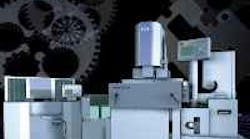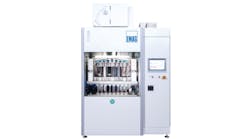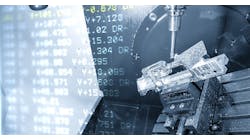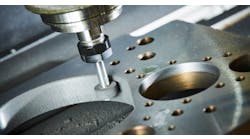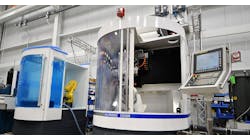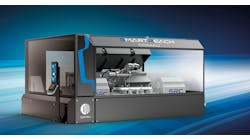Going from a 32-bit CNC-style to a combination PC-NC, 64-bit control creates an EDM that easily interfaces with operators and other machines.
EDMs in Mitsubishi's new QA and EA Series fit into manufacturing cells easily because they speak a PC language familiar to integrators.
THe EA8 sinker EDM showcases a new PC-NC and motor resolution that has gone from 0.5 microns to 0.1 to 0.2 microns for finer stepping increments.
Mitsubishi's QA Series wire EDMs feature a traveling-column design along with the company's new PC-NC.
An EDM that interacts well with a group is one way to describe a machine with Mitsubishi's new control. The 64-bit, combination PC-NC sports a Windows 95 front end that not only provides a familiar platform for operators but also makes the company's EDMs more compatible with shop networks and production cells.
Up until now, companies have pretty much developed their own hardware and software control styles, says Greg Langenhorst, EDM product manager at Mitsubishi. And, internal communication to and from a machine is usually specific to that particular control style. Typically, machines are connected to an interoffice system via an RS-232 port and separate PC. With the new control, the EDM becomes one of the PCs in the network.
What Mitsubishi's control supplies is a common or recognizable user inter-face (Windows 95) even when different controls are involved. This common access language makes it easier for manufacturing-cell integrators to communicate with the EDMs in the cell. For example, a part may first be cut on a turning center, then a machining center, and from there move to an EDM. Three different machines are involved in part production.
In the past, parts would stay together and move from one operation to the next. Now, they travel individually around a manufacturing cell that contains all the needed machines and exit as completed parts. These cells must have one control computer that simultaneously communicates with the computers on the other machines to monitor cell action. Without a common language, integrators have to write special code to communicate with the various machines.
Adding new or different machinery to cells can be expensive because the code has to be rewritten. But machines such as the EDMs in Mitsubishi's new QA and EA Series speak a PC language familiar to the integrator, which makes it an easier and less costly process.
The QA Series line of wire EDMs incorporates the company's new control and replaces Mitsubishi's SX series. These new machines have a traveling-column design, and Mitsubishi believes they are more accurate and produce finer surface finishes than SX series machines. On the sinker side, the PC-NC is inside the new EA machines, which have gone from a 0.5 micron motor resolution to a 0.1 to 0.2 micron resolution for finer stepping increments. This means the machines position and orbit more accurately, control size better, and process information faster than an EX8.
Total part processing time
Because roughing speeds of EDMs have, for the most part plateaued, shops focus on decreasing total part processing time by skim cutting more efficiently, says Langenhorst. Most jobs have only one rough pass, but may require as many as three skim passes. The key is to complete the skim passes as quickly as possible yet maintain accurate sizes, even in the corners. This is where cornering technology and servo response time comes into play, says Langenhorst.
Servo response time is how fast the machine senses stock amounts in the gap and responds by either slowing down upon entering an inside corner or speeding up for an outside one. To do this (maintain precise corners during skimcutting), the QAs use a feature called Corner Master II.
It actually debuted on the FXK Series machines, but it is running in unison with a 32-bit control. On the new machines, Corner Master II works with the 64-bit control to sense gap feedback information faster, letting it adjust servo rates and power settings even quicker.
"The new control," explains Langenhorst, "simply routes information coming from all the separate processors within the EDM at a much quicker pace." To illustrate, he mentions the separate processor for voltage-feedback information from the gap. This processor sends information to a front processor, which then displays it and decides whether or not to make adjustments.
"The faster all this happens," says Langenhorst, "the more efficient the cut and the shorter the overall part processing time. EDM, he goes on to say, is known for one-part, two-part jobs and not so much for high-volume production. But, more shops are using EDM for that type of work because of the machines' growing unattended-operation capabilities along with increasing skim-cut speeds. "This is especially beneficial for aerospace materials that are hard to cut with standard mills and drills," adds Langenhorst.
What's in it for the enduser?
Besides the more familiar operating system, endusers will see a smaller machine package, more hard drive memory, customized tool bars, better graphics, and, easier program editing. All this because of the new control.
According to Langenhorst, a CNC-style control usually has a card bucket measuring about 1 ft 2 , holding maybe 8 or 10 boards. Going to a PC-style control shrinks the required cabinet size significantly— to about the size of a laptop, he adds. Mitsubishi will now use a 10.4-in. liquid crystal flat screen as opposed to a 14-in. tube. This also reduces heat generation.
As control cabinet size shrinks with the new control, available hard drive memory expands. The current QA version has 10 Mbytes of hard drive space reserved strictly for enduser purposes such as program storage. This is quite dramatic, comments Langenhorst, when one considers that most machines offer only RAM not hard drive memory. Also, the new control lets users customize tool bars and other on-screen items, like on a typical laptop computer.
Operators can decide what to view and then position items in places that are most familiar to them. The closest today's machines come to this are split-screen capabilities, but they are not presetable—where operators can hit one button and bring up a specific screen combination, says Langenhorst.
While using the new control, operators can call up only the information they need to see and get rid of the rest. This keeps fledgling operators from getting overwhelmed by a screen full of information they don't yet under-stand. As these new operators progress and learn, they can add more information to the screen. For experienced operators, Windows 95 is a multitasking system that lets them open more windows at one time to do various tasks simultaneously.
Shops with the new machines will be viewing better on-screen graphics, especially beneficial for verifying complicated, 4-axis independent taper work. This kind of taper involves a particular shape at the top and a completely different one at the bottom, common on molding, plastic extrusion, and draw die parts.
Typically, machines plot the top shape, bottom shape, and the middle of the workpiece or where the height has been set. "For the most part, operators see three lines on the screen—one for top, middle, and bottom along with a few framing lines," says Langenhorst. The PC-based control presents a more complete and in-depth 3D visual simulation of how the shape will appear.
The new control makes program editing commands common for such things as inserting or deleting a line or moving items. Editing languages for these types of activities usually vary from one machine type to the next. A common editing format means machine software developers do not have to create editors. Mitsubishi took advantage of this feature while developing the new machines.
For the 64-bit machines, the company side-stepped the hassle of rewriting its Command editor's 32-bit language for the new control. The company simply used the existing word editor in Windows 95.
The future
What does a 64-bit PC-NC implicate for the future of EDM? For the distant future, EDMs may be accepting DFX files directly, and for the very near future, it is the Internet. In fact, Internet access was a driving force behind developing the new control.
Now, Mitsubishi experts are considering an intriguing question: If there is a Windows 95 PC in the new control, why couldn't there be a different type of post processing, so DFX files would go right into the EDM? According to Langenhorst, it's not here yet, but this is the direction of thought.
The company's aim is to supply remote diagnostics using software that lets one computer dial up another with the same software. Once connected, one person at a single PC could run the other computers on line, perform diagnostics and repair service, or offer programming help. While most of this is already happening with EDM, the new Mitsubishi control makes it a lot easier as compared to what's out there, says Langenhorst.
